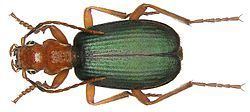Scientific name Brachinus crepitans Higher classification Brachinus Order Beetle | Family Carabidae Subgenus Brachinus (Brachinus) Rank Species | |
 | ||
Similar Brachinus, Beetle, Brachininae, Brachinus sclopeta, Anchomenus dorsalis | ||
Brachinus crepitans is a species of ground beetle in the Brachininae subfamily that can be found everywhere in Europe, except for Monaco, Norway, San Marino, Vatican City, and some islands such as Cyclades, Gibraltar, Iceland, Madeira, Malta, North Aegean, Novaya Zemlya, and Savage Islands. It can also be found in every Central Asian and Middle Eastern country except for Afghanistan. North African countries have them too.
Contents
Etymology
The name of the species derived from a Latin word which means crackle because it makes crackling noise.
Description
Brachinus crepitans can reach a length of 7–10.2 millimetres (0.28–0.40 in), with an average of 8 millimetres (0.31 in). Head and protum are brown, while elytrae are greenish. The species is very similar to Brachinus efflans.
Ukrainian distribution
In Ukraine the species was found in steppes of Lviv, near Osovitsa village of Podolian Province in Western Ukraine. It was also found in Zolochiv, Kharkiv Oblast.
UK Distribution
Most of the time the species can be found in southern England and southern Wales where its abundant in coastal areas. The inland locations have been sited as well through, the most recent of which are Cotswolds and Northamptonshire where it was discovered in limestones. It was also found in boulder clay in Huntingdonshire, and in Brotheridge Green, an old railway line and wildlife reserve that was located near Malvern, Worcestershire. The species were found in the 1970s by Ian L. Crombie.
Ecology
The species fly from May to June, but the lifecycle is unknown. There is a theory that the larvae have some external parasites that feed on the pupae of other beetle species, especially ground beetles. Examples of such species would be Amara convexiuscula and a staphylinid beetle, Ocypus ater.
When disturbed, the species shoot liquid from two glands through their anus. Since one of the glands contains hydrogen peroxide and the other hydroquinone, when two the contents mix with enzymes in a "firing chamber", the liquid explodes, and harms the attackers.
Habitat
The species can be found in dry and sunny areas, and usually under stones. It can also be found in calcareous grasslands, arable land, and chalk quarries.
